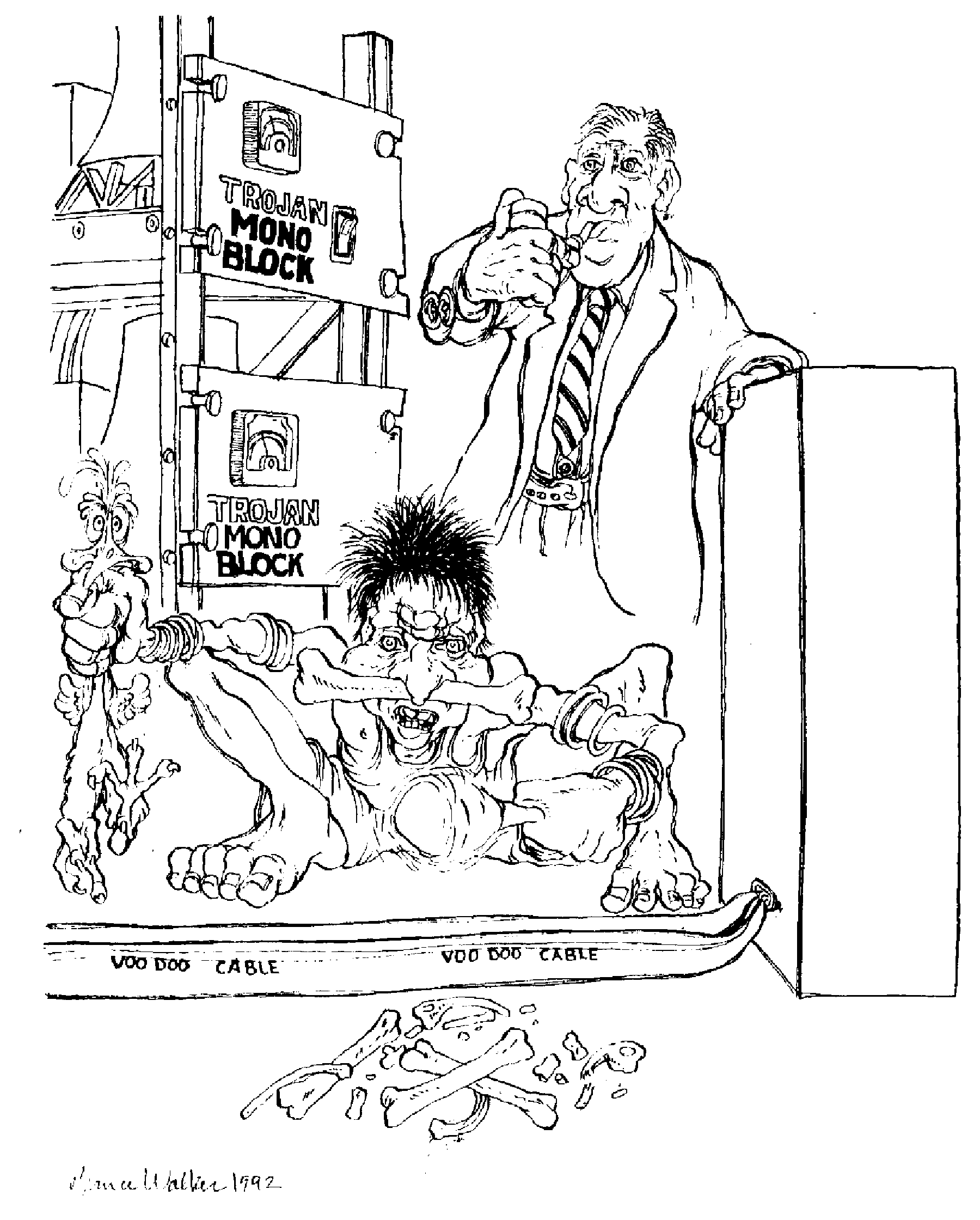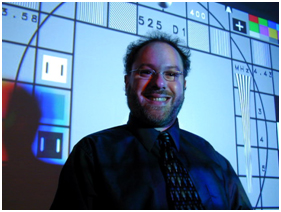Roger Skoff of RSX Technologies at the LAOC Gala, 2023 (portrait and image processing by David W. Robinson)
Roger Skoff writes about doing the right things the wrong way
You wouldn't do that, would you—eat soup with a fork? Or paint your house with a Q-tip cotton swab?
Or run a cement mixer in a drag race? You know about such things, and you know that to use even the best quality tool for a purpose it's not designed for is to risk getting either less than the best possible results, no usable results at all, or even making whatever the problem was even worse.
It's true that the back of a hatchet (or even a brick) can be used for driving nails, but a hammer will do it better and more accurately. A tree can certainly be cut down with a knife, but an axe will do a better job. And covering your head with a plastic bag will keep your hair dry but an umbrella will not only do it better, but will keep your whole body dry at the same time.
Evaluating audio equipment and choosing which specific products to use in a specific home system is one of the areas where, all too many times, people—both the general public and audiophiles, alike—use the wrong tool for the job at hand, and the results can be both disappointing and unnecessarily expensive.
The first thing to do when approaching any task is to determine what that task is and what you're trying to accomplish. With a nail or a screw, that's fairly obvious. In general, you're either trying to hang a picture or hold two things together, and all you have to do to pick the right tool is to look at the fastener: If it's got threads, use a screwdriver; if not, use a hammer.
Picking HiFi components, though, is different in an important way.
Virtually all HiFi products have at least two basic functions: They must look good enough to please you, to fit in with your décor, or to justify (or, if they're in the stratospheric price range, to show off and make obvious your bragging rights to) their expense. They must also sound good enough, in your own listening room, to justify selecting them above however many other products of the same kind you may also be considering..
Sounds and looks. Two different tasks; two different tools.
If all of HiFi were performance-built and performance priced, putting together a system might be a lot easier than it is now. All you'd have to do would be to pick a price point, "X" dollars, for example, and go to a dealer, the Internet, or even a paper catalog; look at what's available; see if it would go with your home, its furnishings, with the size and shape of your listening room, and where in the room you expect to put your system. Then, if you were satisfied that it would make the impression you want on yourself, your family, and any visitors you may show it to, you could just then write a check or hand over your credit card, and the deed would be done...
That would cover the "looks" part, and your eyes (or those of your family or anyone else you might be trying to please or impress) would be the right and only tools that you'd ever need to use.
Correspondingly, your ears are the obvious tools for evaluating the "sound" part of your system's function, and that's where a great many people go off track and either use the wrong tool or no proper tool at all in making their decisions.
To explain this, let's start from the beginning: the music. Correctly and enjoyably reproducing the music is the ultimate goal of every HiFi system, but is that possible? The answer, I'm sorry to say, is doubly disappointing. First off, no; no recording or playback system yet devised has ever been able to exactly record a musical performance without any alteration from its true sound. No microphone has ever been perfect; no mic cable, no mixing console, no recording device, whether analog or digital, has ever been able to record it without change from the original sound. And, even if that were possible, no playback system has ever been able to play back a recording with no changes whatsoever from the recorded information. And even if it could, the only place in which that playback wouldn't be affected by the acoustics of the room it was done in would be an anechoic chamber. And, because those have no acoustics of their own at all, they sound awful, and are suitable for measuring purposes, only. Never listening.
But, even if perfect recording and playback were possible, what would you listen to? No one knows what the music actually sounds like.
As I've written before, what one performer at a recording session hears is different from what any of the other performers hear, just because of where he is relative to where they are. He can't know how it sounds to them or to the conductor (if there is one). The conductor hears the music differently from the performers and the audience (if there is one) and each person in the audience hears it differently from every other, depending on where he or they are sitting in the room. Finally, not even the recording engineer knows what the music actually sounds like, because he's not listening to the music, but to the sound of the music, picked-up by as many as dozens of microphones, all playing for him at once through a headset or monitor speakers. And, if, as is commonly done for "popular" music recordings, the music is recorded on several different tracks (as many as 64), at many different times, with only one section or performer playing at a time, and it's all laid-up and mixed down later, there's never any "original" session at all, and the entire performance is a construct, and, because it never "really" existed, it can never really be reproduced at all.
So, if the music can't be used as a single absolute point of comparison for evaluating the sound of a component or system (an "absolute sound"), what can?
Well, how about measurements? Certainly, getting a quantified readout in black-and-white from some utterly unbiased and absolutely accurate machine must be reliable. No? No. Consider just these two (of many possible) illustrations:
A properly designed and maintained anechoic chamber really does allow speaker designers and engineers to measure and chart with great precision the performance characteristics of a speaker driver or speaker system, and the results are utterly reliable and used by them in their product development and quality control testing. The problem for a home user is that he's not going to play his speakers in an anechoic chamber, and they will with no exception, sound different in his listening room than they did in the environment where they were measured. Also, unless his room is big enough to propagate a deep bass wavelength, (half of one, actually), the speaker's not going to make the described bass, regardless of what the anechoic chamber measurements may say.
It's the same for electronics, cables, and other things, too. Measurements can be truly impressive and seem to have the weight of "science" behind them, but unless the testers are measuring the right thing in the right way, with the right tools and test materials, the tests can be utterly without value.
Two amplifier examples that immediately come to mind are the solid-state amplifiers of the 1980s and 90s that used large amounts of global negative feedback to cancel distortion and come up with spectacular test figures. They regularly showed measured THD (Total Harmonic Distortion) in the 0.001 percent range, or even better, but the amps still didn't sound good. And there were also the tube amps of around the same time that, even with measured THD of up to 2% (sic), which still sounded great nonetheless, and developed a strong audiophile following.
So, you can't rely on measurements, either, but what about reviews?
Maybe, but I'd always prefer to use reviews to rule things out than to rule them in
Most reviewers are audiophiles, just like us. They listen to the same kinds of music we do, in listening rooms very much like our own, and they have tastes and preferences in what they like and don't like, just as we do. Most importantly, though, if you think that an expert is someone who has tried everything, done everything, and can talk or write about it and advise you from direct personal experience, that's simply not the case. There are some remarkably knowledgeable reviewers out there, and the overwhelming majority of them are absolutely honorable and really trying to help you to learn about the products they review, but none of them has ever heard and compared even the tiniest fraction of one percent of all of the HiFi products currently available.
It's simply impossible for them to have done so. The last time I checked, there were some 400 brands (not models, brands) of speakers on the market. To try any one of them, they must be attached to one of at least 100 models of speaker cables, which would be plugged into one of at least 100 models of amplifiers, which must get signal from one of at least 100 models of interconnecting cables, which would get its signal from one of at least 100 models of preamp, which would get its input through one of at least 100 models of interconnect, from one of at least 100 models of turntable, streamer, CD player, tape recorder, radio tuner, or whatever. The number of possible combinations that a reviewer would have to have listened to in order to claim real expert knowledge would be, (starting with the speakers and working back just to the preamp) 400 speakers x 100 speaker cables = 40,000, x 100 amplifiers = 4 million, times 100 interconnects = 400 million, x 100 preamps = 40 billion, without yet even getting to any kind of source device or the cable that carries its signal.
Obviously, the likelihood of having tried even the smallest significant sampling of all of those possible combinations is in the slim-to-none range, but experience is still experience, and it may be worth heeding a reviewer's opinion, at least about what not to try—if his tastes and preferences are similar to your own. If they're not—if they're like those of one reviewer, on whose personal recommendation I tried a piece of gear that was so bright that I thought it might burn my ears off if I listened to it for too long—run away, not necessarily screaming, but at least as fast as you can!
Ears, not measurements, are certainly the right tool for evaluating the sound of things you're considering to become parts of your system, but recordings can't be relied on as an absolute standard of what music actually sounds like, and even the ears of a reviewer are only as valuable to your own choices as his experience, his hearing or listening ability, the system he reviews on, the room he listens in, and his own tastes and preferences make them.
For the task of deciding what's sonically right for you, your own ears, listening to your own choice of music, on your own system, in your own listening room, and acting on what you think it ought to sound like is the only truly "gold" standard, and every step away from that reduces your likelihood of finally making the very best decision.
HiFi dealers have long known that some customers, especially non-audiophile customers, have a fear or aversion to A/B product comparisons. They feel, somehow, that the test is not so much of the components being played as of their own expertise, sophistication, or hearing ability, and would rather simply have the salesperson—a presumed "expert"—tell them what to buy.
Don't do that, and don't just buy blindly by price point or off the internet. Get your dealer to demonstrate what he wants to sell you—preferably in your own home. That way, you'll really know what you're buying and what to expect it to sound like when you hear it in your own system, in your own listening room.
By comparison, anything else would be like eating soup with a fork.
Drawing by Bruce Walker.









































